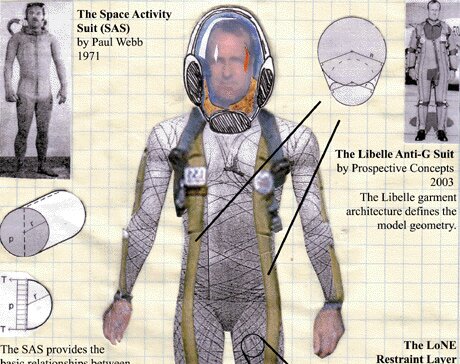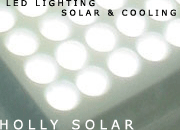Spacesuit Art
 Imagine a “very stuffy” museum. The images all over every wall are too much to process. Except for one small Flamenco dancer on the only canvas in one whole room of the Isabella Stuart Gardner Museum. It was the only image Bradley Pitts related to. In a site-specific piece, the architecture at first dominated him, but in “Presence” (2002), he grew to fill the space; eclipsing it. Within 3 minutes, the fabric draped around the aerospace artist inflated to 12x12x9 feet. Then, after 2-3 times the duration, he disappeared into the deflated membrane on the floor. Marshall McLuhan described media as the extensions of mankind, including clothes which extend the thermal regulation of the body by the skin. With a Master’s Degree in what amounts to Spacesuit design from MIT, Pitts deals with the spaces on both sides of the epidermis and beyond. His works harken back to the days when scientific exploration was as much a meditation on personal philosophy as universal fact. Another performance, “Body Flux” (1996), suggested similarly soft skins of survival. Compartmentalized by womb-like isolation with voyeuristic vulnerability, it enveloped him in clear plastic, blinded him with cameras over his eyes, and collected his gasses and waste for an hour. Pitts feels that although the manned space program has aided a plethora of scientific and industrial experiments, it is a shame how much aerospace research has contributed to militaristic applications.
Imagine a “very stuffy” museum. The images all over every wall are too much to process. Except for one small Flamenco dancer on the only canvas in one whole room of the Isabella Stuart Gardner Museum. It was the only image Bradley Pitts related to. In a site-specific piece, the architecture at first dominated him, but in “Presence” (2002), he grew to fill the space; eclipsing it. Within 3 minutes, the fabric draped around the aerospace artist inflated to 12x12x9 feet. Then, after 2-3 times the duration, he disappeared into the deflated membrane on the floor. Marshall McLuhan described media as the extensions of mankind, including clothes which extend the thermal regulation of the body by the skin. With a Master’s Degree in what amounts to Spacesuit design from MIT, Pitts deals with the spaces on both sides of the epidermis and beyond. His works harken back to the days when scientific exploration was as much a meditation on personal philosophy as universal fact. Another performance, “Body Flux” (1996), suggested similarly soft skins of survival. Compartmentalized by womb-like isolation with voyeuristic vulnerability, it enveloped him in clear plastic, blinded him with cameras over his eyes, and collected his gasses and waste for an hour. Pitts feels that although the manned space program has aided a plethora of scientific and industrial experiments, it is a shame how much aerospace research has contributed to militaristic applications.
Spacesuits in Science Fiction have the luxury of looking slimmer than the Michelin Man in 1960’s moonwalk media, but they’re not strictly fictional. Bradley Pitts proposed a hybrid of several svelte designs so perhaps future astronauts revisiting the Moon en route to walks on Mars will not be using 50 year-old-plus designs. “Klein Suit” (2001) combines tighter-fitting concepts that date back to the Space Race themselves, but were not developed by NASA; perhaps due in part to the materials technologies available during the era. Every person has points on their skin that do not stretch when their bodies move. Lines drawn between these points are Lines of Non-Extension (LoNE). In 1964 A.S. Iberall proposed “The LoNE Restraint Layer”, tracing those lines with cables to cage in the body from being torn asunder in a vacuum, while maintaining mobility. Seven layers of snug Spandex that would make even David Lee Roth uncomfortable have also been found to help protect humans in a vacuum. Paul Webb proposed the “Space Activity Suit” (SAS) in 1971. The body breathes through the skin as well as the mouth and nose. Maintaining pressure is important not only for vacuum safety, but for blood circulation and its Oxygen concentration as well. While the Earth’s atmosphere exerts a certain pressure on us, it contains other gasses. If the body is provided with pure Oxygen, it can be done at lower pressure than our atmosphere.
G-suits help maintain pilots’ circulation when they experience multiples of Gravity’s force during certain maneuvers. In 2003, the Libelle Anti-G Suit by Prospective Concepts suit replaced the external pumps mounted within aircraft and their requisite octopus of hoses that interface to other suits. Water enclosed in channels moves via natural hydraulics to push blood automatically around the wearers’ extremities. Suits of many kinds have been designed for performing different tasks underwater, in multiplied gravity and lack thereof. “Klein Suit” combined the results of Iberall and Webb, 3-D scans and plastic molds of Pitts for his experiments: “The SAS provides the basic relationship between mechanical couterpressure, material tension, and radius of curvature. Combining results from Iberall and Webb defines material geometry and area of exposure.”
His wearable art tests the maxim that if you look far enough into space, perhaps you’ll return to your vantage point. This philosophy can be interpreted as karma, a cyclical universe, and introspection to name a few. In “Donning the Void”, Bradley performed mundane tasks; keeping the vacuum of space around his arm within the cloth, rigid cylinder and flexible rubber gaskets that comprised his “Vacuum Cuff”. In “Focus” he is designing an internally mirrored mask where the two focii of an ellipse focus the image of each eye into the other. Rather than seeing two separate eyes, the brain would perceive a composite third eye, or “Introspective Optics”. Preparatory models for “Focus” in turned balsa wood and Aluminum comprise physical conceptual "Objects of My Meditation” (2004).
He drew our attention to the work of Canadian artist Janet Cardiff and her binaural recordings, which use stereo microphones on or in the ears. Physically separated to approximate the shape, size, and density of the human head, the microphones can be worn or mounted within a model. She apparently recorded herself giving a tour through a museum and produced a CD for visitors. Carrying a portable CD player, visitors expereince similar auditory spatializations as Cardiff, and might hear children but not see them due to a temporal and perhaps spatial displacement.
In “Superimposition”, Pitts linked two stethoscopes headsets together with common tubing to “slip between” each other’s ears. He tried it with two pairs of linked noise-canceling headphones, but felt the image of the two stethoscopes was more impressive than the more technologically facilitated experience. Mr. Pitts is interested in preserving the live perception of his live works. He does not want to mediate the experience of the present so much that users feel like they might be sensing something that may as well be pre-recorded. I felt the final diagram he shared with us incorporated his interests in space with shared interpersonal experience. “Light Bridge” would divert the Athens sun up to an extra-terrestrial mirror and back onto the site of an Olympiad. It summarized his presentation of multiple ways to conceptualize “reflection”.
Check out images and words by the artist at http://bradleypitts.info.
[ Article thanks to Wareaware (wearaware at yahoo.com). ]


